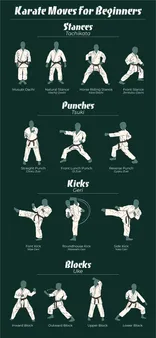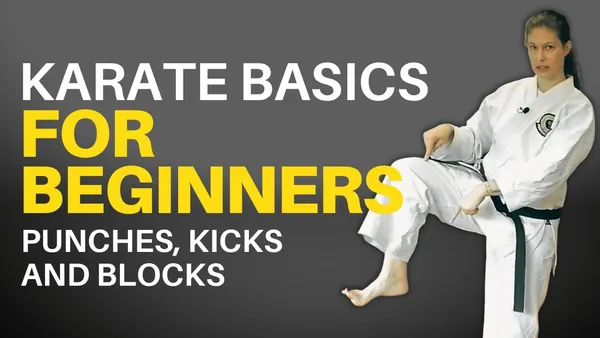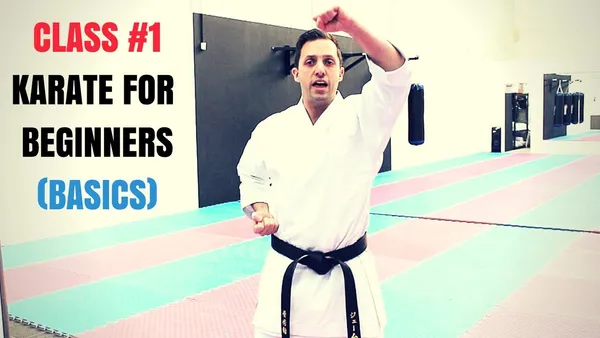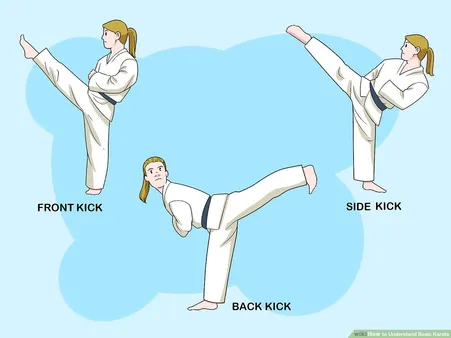Table of Contents
Welcome to Kizworld, your trusted source for martial arts knowledge and ise. In the realm of martial arts, mastering the basic techniques and moves is the cornerstone of a successful journey. Whether you seek self-defense, fitness, or personal growth, understanding these fundamentals is paramount. In this comprehensive guide, we'll embark on a detailed exploration of the basic martial arts techniques and moves, unraveling their significance and providing practical tips to help you master them. Join us as we delve into the world of martial arts, unlocking the secrets of effective self-defense and personal empowerment.
How to Learn the Basic Martial Arts Techniques and Moves: A Beginner's Guide to Self-Defense
I. Learn the Basics of Martial Arts Techniques and Moves
Learn the Basics of Martial Arts Techniques and Moves
1. Understand the Basic Stances
Start by learning the fundamental martial arts stances. These stances provide a solid base, enhance balance, and allow for quick movement. Common stances include the horse stance, which offers stability and power; the cat stance, which enables swift direction changes; and the front stance, suitable for attacks and defense. Mastering these stances forms the foundation for more advanced techniques.
Related Post: How to Choose the Right Martial Art for You
2. Practice Basic Strikes
Strikes are the building blocks of martial arts. Learn how to execute punches, kicks, and elbows effectively. Focus on proper form, power generation, and accuracy. Punches include the jab, cross, hook, and uppercut. Kicks encompass front kicks, roundhouse kicks, and side kicks. Elbows involve the straight elbow strike and the back elbow strike. Practice these strikes individually and in combinations to develop a well-rounded striking arsenal.
Related Resource:The Benefits of Martial Arts for Physical and Mental Health
3. Master Basic Blocks and Evasions
Learning to defend yourself is crucial in martial arts. Study how to block incoming strikes, kicks, and elbows using your arms, legs, and body. Blocks include the high block, low block, and middle block. Evasions involve slipping, ducking, and weaving to avoid attacks. These defensive techniques are essential for staying safe during sparring or real-life confrontations.
Related Post: The Best Martial Arts Equipment and Gear
Technique | Description |
Horse Stance | Provides stability and power. |
Jab | Quick, straight punch. |
Front Kick | Powerful kick with the front of the foot. |
High Block | Blocks strikes aimed at the head. |
Slip | Evasive maneuver to avoid strikes. |
4. Develop Fundamental Grappling Skills
Grappling involves controlling your opponent on the ground using holds, locks, and throws. Learn how to take down your opponent, maintain dominant positions, and apply submission holds. Some basic grappling techniques include the single-leg takedown, the guard position, the mount position, and the armbar. These skills are essential for self-defense and competitive grappling.
Related Post: How to Improve Your Speed, Power, and Agility with Martial Arts
5. Practice Sparring Regularly
Sparring is a controlled fight that allows you to apply your techniques against a live opponent. It helps you develop your skills, test your abilities, and build confidence. Sparring also teaches you how to handle pressure, stay calm under stress, and adapt to different situations. Attend martial arts classes that offer regular sparring sessions to enhance your overall martial arts proficiency.
Related Resource: The History and Philosophy of Martial Arts
II. Mastering Fundamental Stances and Footwork
Mastering Fundamental Stances and Footwork
In martial arts, mastering fundamental stances and footwork is the foundation of effective movement, balance, and power.
Stances provide a stable base and allow for quick transitions between techniques. There are many different stances in martial arts, each with its unique purpose and advantages. Some common stances include:
Stance | Description | Purpose |
Horse Stance | Feet shoulder-width apart, knees bent, and toes turned slightly outward. | Provides stability and balance. |
Front Stance | One foot forward, the other back, knees slightly bent. | Provides mobility and allows for quick attacks. |
Back Stance | One foot back, the other forward, knees slightly bent. | Provides power and stability for defensive moves. |
Side Stance | Feet parallel, one foot slightly forward, knees slightly bent. | Provides stability and allows for quick side-to-side movement. |
Cat Stance | Low stance with the knees bent and the feet close together. | Provides agility and allows for quick changes in direction. |
Footwork is the movement of the feet to create angles, evade attacks, and position oneself for optimal strikes or grapples. Good footwork allows martial artists to move smoothly and efficiently, while maintaining balance and stability.
Some of the most important aspects of footwork in martial arts include:
- Agility: The ability to move quickly and easily in different directions.
- Balance: The ability to maintain stability while moving or being attacked.
- Coordination: The ability to coordinate the movement of the feet with the rest of the body.
- Power: The ability to generate power through the feet and legs.
- Speed: The ability to move quickly and explosively.
Mastering fundamental stances and footwork is not only essential for beginners but also for experienced martial artists looking to improve their skills. By practicing these basics regularly, martial artists can develop the foundation for effective and dynamic movement.
Here are some tips for mastering fundamental stances and footwork in martial arts:
- Start by practicing stances in a stationary position. Once you feel comfortable with a stance, start moving around while maintaining the stance.
- Focus on maintaining proper body alignment and balance in each stance.
- Practice transitioning between different stances smoothly and quickly.
- Incorporate footwork drills into your training regimen to improve your agility, balance, coordination, power, and speed.
- Practice footwork with a training partner to get a feel for how to move and react in dynamic situations.
By following these tips and dedicating time to practice, martial artists can master fundamental stances and footwork, which will greatly enhance their overall skills and techniques.
To learn more about the basic techniques and moves in martial arts, check out our related posts on how to punch, how to kick, and how to block.
III. Executing Basic Strikes, Kicks, and Blocks
Executing Basic Strikes, Kicks, and Blocks
Mastering the fundamental techniques of striking, kicking, and blocking is crucial for effective martial arts practice. These techniques form the foundation of self-defense and offensive maneuvers, providing a solid base for advanced skills.
To execute a proper strike, stand with your feet shoulder-width apart and your knees slightly bent. Keep your hands in front of your body, fists clenched, and elbows tucked in. When throwing a punch, extend your arm fully and rotate your fist at the point of impact. For kicks, lift your knee and extend your leg, aiming for the target with the ball of your foot or shin. Maintain your balance and stability throughout the strike.
- Jab: A straight punch thrown with the lead hand, targeting the opponent's face or body.
- Cross: A powerful punch thrown with the rear hand, aiming for the opponent's head or body.
- Hook: A circular punch thrown with the lead hand, targeting the opponent's head or body.
- Uppercut: An upward punch thrown with the rear hand, targeting the opponent's chin or body.
To execute a proper kick, stand with your weight evenly distributed on both feet. Bend your knee and raise your leg, keeping your heel close to your buttocks. Extend your leg and snap your foot forward, striking the target with the ball of your foot or shin. Maintain your balance and stability throughout the kick.
- Front kick: A straight kick thrown with the lead leg, targeting the opponent's body or head.
- Roundhouse kick: A circular kick thrown with the rear leg, targeting the opponent's head, body, or legs.
- Side kick: A kick thrown with the side of the foot, targeting the opponent's head, body, or legs.
- Back kick: A kick thrown with the heel, targeting the opponent's head or body.
To execute a proper block, stand with your feet shoulder-width apart and your knees slightly bent. Keep your hands in front of your body, fists clenched, and elbows tucked in. When blocking a strike, move your hand or forearm to intercept the attack, deflecting it away from your body. For kicks, lift your knee or shin to block the strike, absorbing the impact and preventing injury.
- High block: A block used to defend against attacks to the head or face.
- Middle block: A block used to defend against attacks to the body.
- Low block: A block used to defend against attacks to the legs or groin.
- Inside block: A block used to defend against attacks from the inside.
- Outside block: A block used to defend against attacks from the outside.
Regular practice and repetition are essential for developing proficiency in executing basic strikes, kicks, and blocks. Start slowly and focus on proper technique, gradually increasing your speed and power as you gain confidence. Martial arts training can provide a comprehensive workout for the body and mind, improving your fitness, flexibility, and mental focus.
IV. Applying Techniques in Martial Arts Forms and Sparring
Applying Techniques in Martial Arts Forms and Sparring
Martial arts techniques are applied in various forms, including basic techniques, advanced techniques, and combination techniques. These techniques are practiced in isolation and in combination with others to develop proficiency in different situations. In martial arts forms, such as kata or taolu, techniques are performed in a predetermined sequence to demonstrate the principles and applications of the art.
Techniques are also applied in sparring or randori, where practitioners engage in controlled combat with a training partner. This allows them to practice and refine their techniques in a realistic setting and to develop their tactical skills. Sparring also helps practitioners to develop the ability to react spontaneously to an opponent's attacks and to adapt their techniques accordingly.
Gear | Features |
Headgear | Protects the head from strikes |
Mouthguard | Protects the teeth and mouth from injury |
Hand wraps | Support the wrists and knuckles |
Gloves | Cushion strikes and protect the hands |
Shin guards | Protect the shins from kicks |
Groin protector | Protects the groin from strikes |
"Sparring is an essential part of martial arts training as it allows practitioners to apply techniques in a controlled and safe environment."- Grandmaster Tae Kwon Do Shil, 9th Dan.
In addition to forms and sparring, martial arts techniques are also applied in self-defense and weapons training. In self-defense, techniques are used to neutralize an attacker and escape from a dangerous situation. In weapons training, techniques are used to learn how to use and defend against various weapons, such as knives, swords, and staffs.
- Forms: A series of predetermined movements that teach the basic techniques and principles of a martial art.
- Sparring: Controlled combat between two martial artists that allows them to practice and refine their skills.
- Self-defense: Techniques used to neutralize an attacker and escape from a dangerous situation.
- Weapons training: Techniques used to learn how to use and defend against various weapons.
Martial arts techniques are a valuable tool for self-defense, fitness, and personal development. By practicing these techniques, individuals can improve their physical and mental health, learn how to defend themselves against an attacker, and develop a sense of inner confidence and self-discipline.